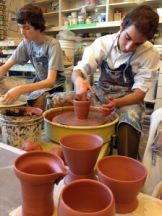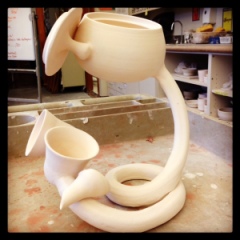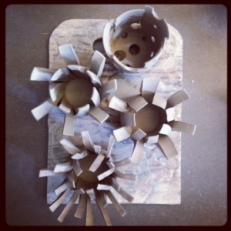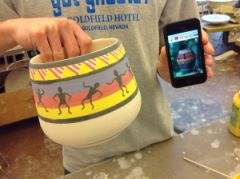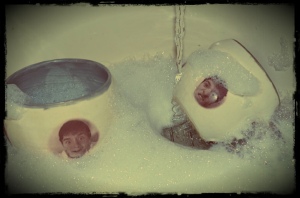This post is for my friend Jared Ward.
Jared is fascinating. He’s a potter and a ceramics teacher who transitioned to the world of Educational Technology a few years ago. We collaborated on a presentation at NCECA last year – working back and forth across the country, from Utah to Pennsylvania, to put some form to ideas about the relationships between technology and the high school ceramics studio. During our conversations, Jared told me that he transitioned worlds in order to stay in front of the changes that are coming to education. Makers have been doing project-based learning since before it was a buzzword. With his unique qualifications, Jared is guiding a conversation about how our hands-on, messy world and the new landscape of technology might enhance each other as they inevitably interact.
As I write this, I’m sitting at the table in the ceramics studio after school. A couple of students are trimming pots; one is throwing; another is glazing a complex teapot. Another student – a visitor to the studio – is watching video clips on his laptop computer, while a few others watch and laugh over his shoulder. I’d normally reprimand or redirect his focus, but today I just watch, and write. I’m struck by the difference between the culture of making and the culture of consuming.
Drew is glazing his third coat now, double-checking every surface of a complex form. He is adding something new to the world, and we are all excited about how this piece will emerge from the kiln later this week. Colin is carefully trimming his first porcelain cup, headphones on and hands steady. Mike is carefully designing the foot on his third iteration of a bowl. The first two cracked on the bottom, so he is being extraordinarily careful with this one, a birthday gift for his sister. They are all serious, focused, and immersed in what they are working on – all independent work. None of them seem like they are sixteen or seventeen years old.
The video-watchers sip tea, joke about cat videos, and seem like… typical teenagers.
The process of making might land us with some amazing end products – like that teapot I will unload tomorrow morning – but I believe that making is not just an end in itself. Making connects us to the development of other characteristics – like perseverance, grit, follow-through, creating multiple iterations, patience, and flexibility. What happens when students value both the process and the product of learning? When the product is something demonstrable, something that has greater form than a test or essay that can be tucked away in a drawer?
We connect process and product every day in a ceramics studio. Even on the days when I have to present information, or demonstrate, my students hands are usually busy with sanding, trimming, or sculpting. Making becomes a habit, a good habit, a very different habit from the sit-and-listen habits of general education. Students learn that they have a responsibility to add value to the world, through the work that they do and the pieces they create. At first, that responsibility might be to a grade. But after they are hooked, it becomes something else, something bigger. The students working in the studio today are are all working independently. None of their projects will be assessed or graded – except to their own standards.
One might argue that a ceramic pot is old-fashioned or archaic, but it is definitely authentic. It takes up and holds space. It has presence in the world, for better or for worse. Good working habits frequently – but not always – lead to good pots. There are lessons to be learned in chance and accident, too, authentic lessons about giving up control (to a kiln, to the teacher who loads it, to a glaze… to a partner, to life circumstances, to climate…). When pieces are unloaded from the kiln, we celebrate or console each other.
—
“21st century education is not about technology,” a school leader told my students, a few days ago.
“Then what is it?” asked a bold young man. Many of the changes in our school have focused on integrating technology, so his surprise was no surprise, really.
“It’s student-centered learning. And project-based learning. And… it’s the work that you just did,” referring to the project we had collaborated on over the last few months.
I’ve been forming my own anti-buzzword definition of 21st century education lately. We are fourteen years into that century, so I feel like the nomenclature has lost its novelty. What I want my classroom to be: authentic process, authentic product, and culture of making. Teachers and students sold on the value-added of both the learning and the outcome of that learning – not just to the individual learner, but to the world. No consumer culture, no cat videos, and no ‘typical’ teenagers. I’ve seen them capable of so much more.
And this is why I’m so glad that Jared is one of the people steering this conversation. He’s a maker. He’s making sure that the dialogue about educational technology takes up and holds space – like the pots we make. When we talk, our conversations always come back to the idea of adding value – not consuming it, or playing games, or just watching. He’s committed to the idea that technology has to move beyond acquisition of knowledge and ideas – and towards creating meaning and new experiences. With a background in the culture of making, Jared seems to be approaching educational technology with a commitment to something bigger than self. And with a much-needed, very refreshing sense of fun.
Jared tells me he is about to do a TEDX talk. He’s talking educational technology, while throwing pots at a wheel on the stage. I love this guy. We all need heroes.
Some student work that echoes the ideas of process, product, and adding value:
- Julian bit his pieces. Seriously. Claimed porcelain tasted pretty good. Think different.
- Kevin is the only student whom Jared and I both taught – me in high school, Jared at the PA Governor’s School for the Arts.
- Bill’s piece – response to the many questions at the end of high school.
- Walls – Austin V.
- Matt. So many good conversations about depending on each other, in making this work.
- Pat. They come full circle when their work becomes this simple.
- Matt. Sequence.
- JB. Wind.
- Abstract Vessels – Joe K.
- Matt – experimenting with tearing and rebuilding.
- Fingers crossed…
- Dan. Puzzles. Try something new.
- Ryan. This piece was prophetic.
- QR coded cups from the FLOW installation – mpflow2013.com
Jared’s TEDX Talk:
http://www.youtube.com/watch?v=3ETw7meRthQ



